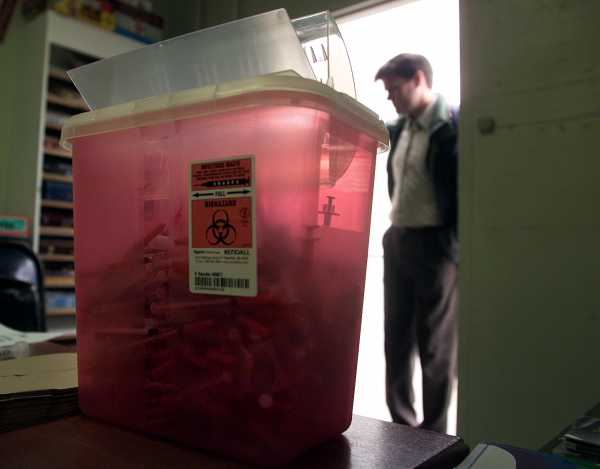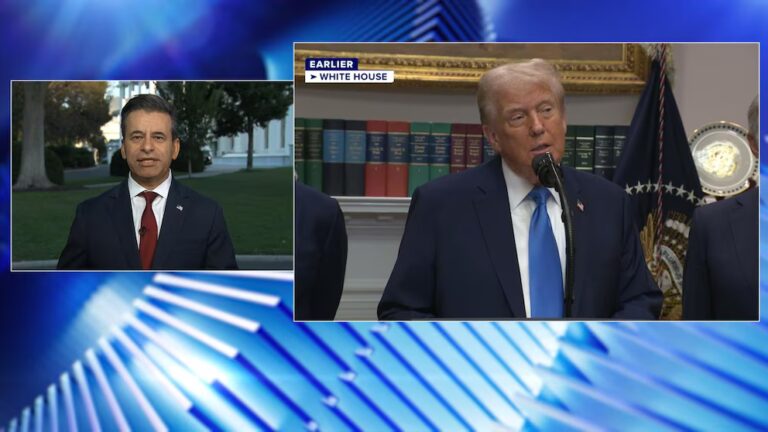
A California court halted Orange County’s only needle exchange program this week — a decision that illustrates the challenges these programs face despite significant evidence for their benefits.
In issuing a preliminary injunction, state Judge Joel Wohlfeil stopped the Orange County Needle Exchange Program (OCNEP) from operating.
The program planned to operate mobile needle exchanges in four cities across the county, with state approval, after the city of Santa Ana decided to shut down the exchange’s permanent location after nearly two years. But Orange County’s government, as well as the cities of Anaheim, Costa Mesa, and Orange (where the program would operate, along with Santa Ana), objected to the mobile exchanges, and filed a lawsuit earlier this year.
Orange County’s argument, like Santa Ana’s, focused on a trope often used against syringe exchanges: the threat of needle litter — the idea that exchanges let people obtain a lot of syringes that are then improperly disposed in public places, exposing the public to the risk of getting inadvertently stuck by a needle.
The court agreed that the needle litter problem in fact preceded the syringe exchange, but it indicated that the needle exchange had exacerbated the problem. That was a big reason for the court’s preliminary injunction.
The county and court’s moves highlight a persistent problem with needle exchanges: Even though they have been researched for decades, and studies have repeatedly supported the benefits of needle exchanges, the programs are often mired by public and particularly local resistance — frequently fueled by stigma and misconceptions about addiction. That’s led to the closing of several needle exchanges, from West Virginia to Indiana to California, even as America is engulfed in its deadliest drug overdose crisis in history in the opioid epidemic.
In a statement, OCNEP condemned the county’s actions and the court’s decision, arguing it will put lives at risk:
The county, for its part, has stood by its complaints about needle litter and the threats it poses. Orange County Supervisor Andrew Do told the Orange County Register, “Because people did not choose to take those risks when walking down the street in the morning or opening a book in the public library.”
For now, the county has landed a big legal victory.
Needle exchanges have a lot of evidence behind them
There is a ton of research showing that needle exchanges work to combat the spread of infectious diseases like hepatitis C and HIV, cut down on the number of needles thrown out in public spaces, and connect more people to treatment — all without enabling more drug use. This is an exhaustive body of research, backed by independent academic researchers, the World Health Organization, and the Centers for Disease Control and Prevention.
Beyond the direct benefits, advocates of needle exchanges argue that the programs can also give a much-needed sense of hope to underserved populations.
Alex Smith, a California resident, previously told me this reflected her own experience with a needle exchange in Ventura County. In 2012, Smith had a bad bacterial infection, MRSA, from reusing needles, with sores covering her face and body. She decided that she could no longer use the syringes she had been using and needed to get a clean supply. So she went to her local CVS.
“They took one look at me at CVS, and they turned me away. I felt so humiliated, disgusted. I didn’t know what to do,” Smith said. “I heard there was a mobile needle exchange in town. So I went to that. … I walked up, and there was a girl there. The first thing she did was smile at me and ask me how I was. I don’t know why that had such an impact on me. But it was the first time someone had treated me with dignity and humanity in a very, very long time.”
Smith went into treatment within weeks, and she said she hasn’t used drugs since then, recently hitting five years of recovery. She now works at a company that helps care for people with intellectual disabilities. She also recently graduated from college, and is now going to graduate school — a step, she hopes, toward helping run the company she now works for. “I wouldn’t have been able to do any of that unless I got sober,” Smith said.
She added, “It’s so much more than just needles. Being treated with dignity and humanity, the power of that is insurmountable. It can shed so much light in the darkest of somebody’s times.”
Needle exchanges aren’t the only solution to the opioid epidemic and related public health problems. But experts argue that needle exchanges are part of a broader suite of solutions, which also includes cutting back excess opioid painkiller prescriptions, expanding access to addiction treatment, and undertaking other harm reduction approaches, such as greater distribution of the opioid overdose antidote naloxone.
Orange County’s program has been mired by needle litter concerns
Despite the evidence, needle exchanges have long faced public resistance.
As a result, the US still lags far behind other developed countries when it comes to needle exchanges. Josh Katz reported at the New York Times: “According to the North American Syringe Exchange Network, 333 such programs operate across the country, up from 204 in 2013. In Australia, a country with less than a tenth as many people, there are more than 3,000.”
Some of the resistance is rooted in stigma around drug addiction. After decades of the US treating addiction as a criminal justice problem instead of a public health concern, much of the public and many policymakers still view addiction as an issue that demands a punitive response, and see those with addiction as part of the problem instead of people who need help. (A common response to just about any opioid story I write, for instance, is that people dying from drug overdoses are just part of “Darwin’s theory in action.”)
There are also more practical concerns, like the needle litter issue raised by Orange County officials.
When Santa Ana decided to shut down OCNEP’s operations in the local Civic Center, it pointed to photo evidence of needles found in the area surrounding the exchange, from needles found in books in the public library to syringes found in the streets. City officials didn’t provide data to back it up, but they told me that OCNEP made needle litter worse, and that the litter problem had gotten better after the program was shut down.
When OCNEP said it would shift to mobile exchanges in the aftermath, officials in Orange County and the four cities where the program would operate objected — arguing that the needle litter problems would explode all across the county.
OCNEP noted that needle litter preceded its existence — a point that Judge Wohlfeil, at least, agreed with. They also argued that they have taken steps, including limiting how many syringes people can obtain and conducting clean-up sweeps, to try to minimize needle litter.
In fact, OCNEP claimed that local government officials’ opposition to the program made it difficult to do more to clean-up work, arguing in a statement that its steps “would have been much more effective if we had a collaborative public health partner in the county.”
In Santa Ana, for example, OCNEP operated at the Civic Center just two hours a week, on Saturday from 1 to 3 pm local time. This meant that clients could go to the program to get a bunch of syringes for the coming week — and they wouldn’t be required to trade a needle for each one they get, since studies indicate that’s less effective for preventing the spread of infectious diseases. But clients didn’t have the exchange to dispose of their needles for the rest of the week, forcing them to find other means for disposal most of the time.
If OCNEP got more public support, and could therefore operate for a more standard five or seven days a week, there might not be as much litter. As Ricky Bluthenthal, a professor of preventive medicine at the University of Southern California, told me, “In an ideal world, you would have a syringe exchange program open for 40 hours a week.”
There’s evidence that needle exchanges may even reduce needle litter if they’re readily available. A 2012 study published in Drug and Alcohol Dependence compared a city with needle exchanges, San Francisco, to one without exchanges, Miami. Through visual inspections, they found 44 syringes per 1,000 census blocks in San Francisco, compared to 371 syringes per 1,000 census blocks in Miami.
Based on a survey of people who inject drugs, the researchers also concluded that those in Miami had more than 34 times the adjusted odds to improperly dispose of syringes in public than those in San Francisco.
Orange County officials, however, have so far resisted officially supporting any kind of needle exchange program. And, this week, they got the county’s only exchange shut down.
Sourse: vox.com






